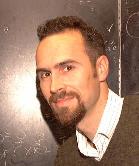 |
Kenneth E. Jansen
Professor 7223 Center for Industrial Innovation (CII) Tel: (518) 276-6755; Fax: (518) 276-4886; E-Mail: kjansen@scorec.rpi.edu [ ME AE & M || Faculty || Online Search ] |

After receiving his B.S. in Mechanical Engineering in 1987 from
the University of Missouri-Columbia, Kenneth Jansen went on to graduate
school at Stanford University where he earned an M.S. degree in Mechanical
Engineering in 1988 and his Ph.D. in Mechanical Engineering with a minor
in Aeronautical Engineering in 1993 under an Office of Naval Research Fellowship.
He then joined the Center
for Turbulence Research, a joint NASA-Stanford program, where he was
awarded a three year post-doctoral research fellowship. In August, 1996
he became a member of the Rensselaer faculty.
Research Interests and Activities Major Interests: Computational mechanics with emphasis on fluid dynamics. Turbulence theory, simulation, and modeling. Parallel computing.
The motivation of Ken's research is to provide engineers with a better predictive capability for fluid dynamics problems, especially those where turbulence plays an non-negligible role. To this end, his research, at the most applied level, seeks to develop simple models which describe the net effect or average of the turbulence upon the mean flow equations. These models, when combined with a fully unstructured-grid finite element method, allow engineers to model arbitrarily complex flow problems. Unfortunately, these models are not yet able to describe all turbulent flows. Therefore, other forms of simulating turbulence are also pursued. These forms are: 1) Large-Eddy Simulation (LES) where the large scale motions of the turbulence are resolved in the computation leaving only the fine scale motions to be modeled, 2) Direct Numerical Simulation (DNS) where all of the turbulent motions are resolved in the computational model. These alternate forms are useful both to develop a more basic understanding of the theory of turbulence and to help improve the averaged models used by engineers.
Click here to view velocity contours on four planes parallel to the wing and one plane normal to the wing from a LES(35k). To see an animation (colorful one) of this flow click one or more of the following animations here(8.9MB), here(11.6MB-long time interval), here(15.5MB-shorter time more frequent sampling smoother), here(a single frame image of the animation). Click here to view vorticity isosurfaces from and LES of turbulent flow over a cavity(1.4MB, might want to wait until night or for a quick view try this one which is a much smaller file but is more fuzzy(44k)). If you have a VERY fast connection and want to see a QuickTime animation of the cavity(4.7MB).
Flow within the human vascular system is usually not turbulent but can still be highly transiatory and quite interesting. Here is a link to the web page describing some of our recent work in this area. The animations were made by one of my undergraduate research assistants in the summer of 2000.
Teaching Activities
Publications and Presentations
Acknowledgements
Much of the material presented above (since Febuary 2000) has been based upon work supported by the National Science Foundation under Grant No.9935840.
Any opinions, findings and conclusions or recommendation
expessed in this material are those of the author and do not necessarily
reflect the views of the National Science Foundation (NSF).